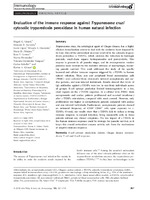Please use this identifier to cite or link to this item:
http://sgc.anlis.gob.ar/handle/123456789/1424| Title: | Evaluation of the immune response against Trypanosoma cruzi cytosolic tryparedoxin peroxidase in human natural infection | Authors: | Girard, Magalí C Acevedo, Gonzalo R López, Lucía Ossowski, Micaela S Piñeyro, María D Grosso, Juan P Fernandez, Marisa Hernandez-Vasquez, Yolanda Robello, Carlos Gómez, Karina A |
Keywords: | Peroxirredoxinas;Predicción del epítopo de células B;Respuesta de células T y células B;Enfermedad de Chagas crónica | Issue Date: | 2018 | Journal: | Immunology | Abstract: | Trypanosoma cruzi, the aetiological agent of Chagas disease, has a highly efficient detoxification system to deal with the oxidative burst imposed by its host. One of the antioxidant enzymes involved is the cytosolic tryparedoxin peroxidase (c-TXNPx), which catalyses the reduction to hydrogen peroxide, small-chain organic hydroperoxides and peroxynitrite. This enzyme is present in all parasite stages, and its overexpression renders parasites more resistant to the oxidative defences of macrophages, favouring parasite survival. This work addressed the study of the specific humoral and cellular immune response triggered by c-TXNPx in human natural infection. Thus, sera and peripheral blood mononuclear cells (PBMC) were collected from chronically infected asymptomatic and cardiac patients, and non-infected individuals. Results showed that levels of IgG antibodies against c-TXNPx were low in sera from individuals across all groups. B-cell epitope prediction limited immunogenicity to a few, small regions on the c-TXNPx sequence. At a cellular level, PBMC from asymptomatic and cardiac patients proliferated and secreted interferon-γ after c-TXNPx stimulation, compared with mock control. However, only proliferation was higher in asymptomatic patients compared with cardiac and non-infected individuals. Furthermore, asymptomatic patients showed an enhanced frequency of CD19+ CD69+ cells upon exposure to c-TXNPx. Overall, our results show that c-TXNPx fails to induce a strong immune response in natural infection, being measurable only in those patients without any clinical symptoms. The low impact of c-TXNPx in the human immune response could be strategic for parasite survival, as it keeps this crucial antioxidant enzyme activity safe from the mechanisms of adaptive immune response. |
URI: | http://sgc.anlis.gob.ar/handle/123456789/1424 | DOI: | 10.1111/imm.12979 |
| Appears in Collections: | Publicaciones INP |
Files in This Item:
| File | Description | Size | Format | |
|---|---|---|---|---|
| IMM-155-367.pdf | Artículo en inglés | 469.42 kB | Adobe PDF |  View/Open |
Page view(s)
123
checked on Jan 2, 2026
Download(s)
41
checked on Jan 2, 2026
Google ScholarTM
Check
Altmetric
Altmetric
Items in DSpace are protected by copyright, with all rights reserved, unless otherwise indicated.

